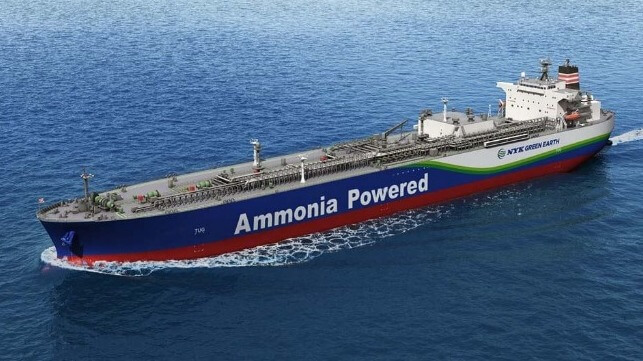Japanese Order First Mid-Sized Ammonia-Fueled Ammonia Carrier

A Japanese consortium of companies working on a project sponsored by the government to develop ammonia shipping reports it has reached the point where it can now begin to build one of the first ammonia-fueled ammonia carriers in the world. The group, which includes NYK, Japan Engine, IHI Power Systems, and Nihon Shipyard, reports it signed construction contacts last month for a vessel which they expect to complete by November 2026.
The new vessel is being reported as “the world’s first ammonia-fueled medium gas carrier.” It will have a transportation capacity of 40,000 cbm of ammonia fuel and be powered by an ammonia dual-fuel two-stroke engine produced by Japan Engine. The goal is to achieve a 95 percent combustion rate on the ammonia fuel mix. In addition, IHI will provide the auxiliary ammonia-fuel auxiliary engine with a mixed combustion rate of 80 percent or higher. The vessel will be built by Japan Marine United Corporation at its Ariake Shipyard.
The consortium was launched in October 2021 as part of a program sponsored by Japan’s New Energy and Industrial Technology Development Organization (NEDO) with ClassNK joining to provide the risk assessments. The effort developed a prototype that overcame the key challenges associated with ammonia and received an Approval in Principle in September 2022. After further research and development, they have agreed to proceed with the construction of the ship, which they believe will contribute to the practical application of ammonia-fueled ships.
They highlight key challenges including the need to manage the toxicity and reduce risk for the crew and the ship. The design they said must prevent leakage from the pipes and tanks. Also, because ammonia is a flame retardant, they have to achieve stable combustion. The vessel also has to treat the potential of nitrous oxide (N2O) emissions which may be generated during ammonia combustion and are a more potent greenhouse gas than CO2.
The effort has already reached key milestones including IHI Power Systems achieved the first stable combustion for ammonia fuel at an 80 percent co-firing rate in a four-stroke engine. The design of the vessel will optimize the hull for ammonia transport. NYK engineers have been consulting to provide proposals on the safety measures for the ship.
They expect that the project as one of the first for ammonia-fueled ammonia carriers will contribute to understanding and knowledge as well as help to shape the regulatory environment. They note that the International Maritime Organization is still studying potential rules for ammonia as there are no international rules in place today for ammonia as a fuel. They note that the consortium has already proposed draft safety requirements and expects to contribute to international rule-making.
The next steps in the project include detailed studies for the vessel’s construction. They will also produce an operating manual for the ship.
The Japanese effort is in addition to programs underway in South Korea. The three major shipyards have each recently begun accepting orders for large ammonia carriers. They anticipate that these vessels will transition to ammonia-fueled propulsion as the technology and regulatory environment is completed.
Japan highlights the critical nature of developing the ammonia value chain. They anticipate a strong demand for transportation capabilities as ammonia emerges as a fuel. They also anticipate that it will be used for co-firing of thermal power plants and as a hydrogen carrier.
